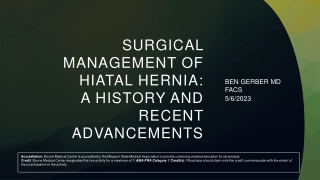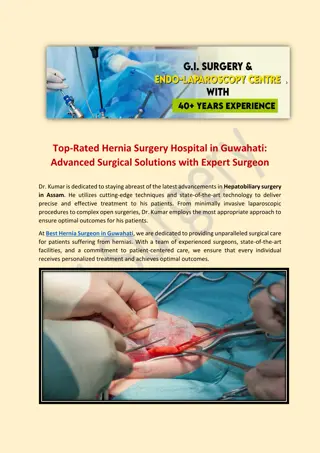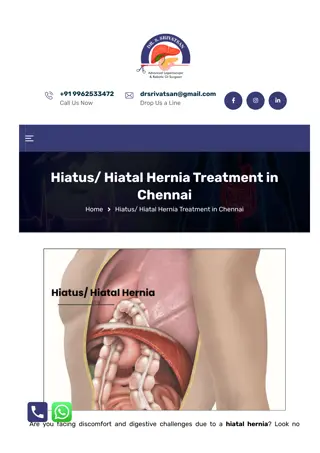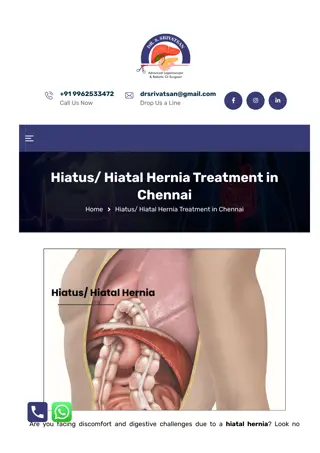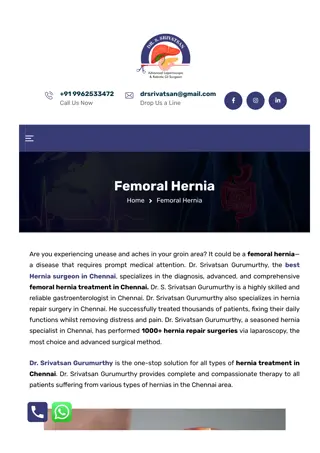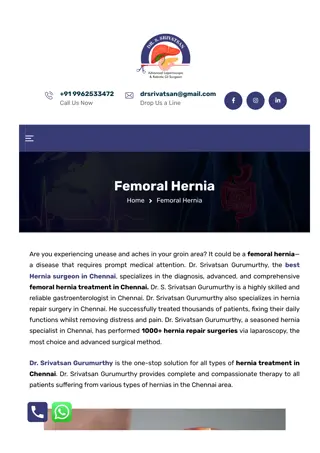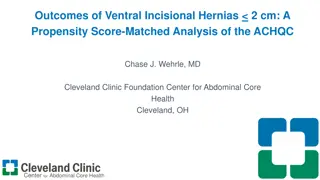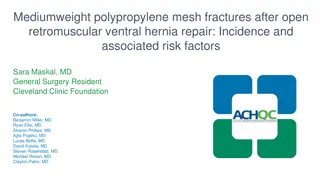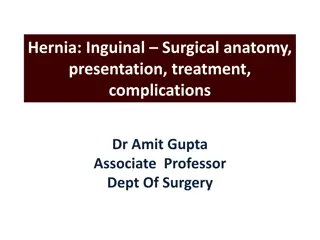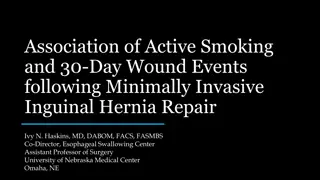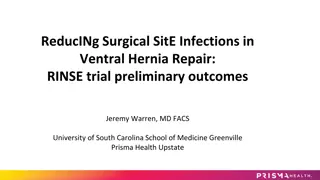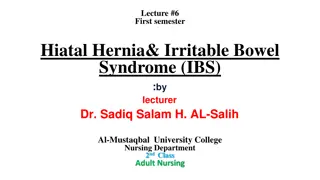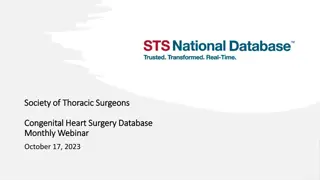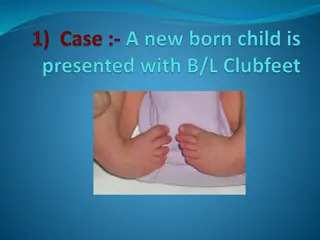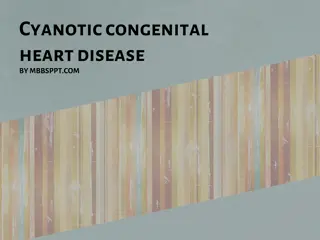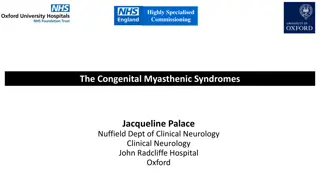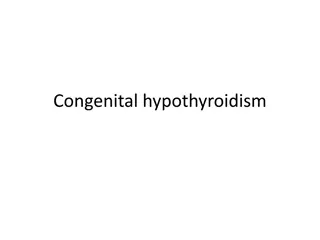Comprehensive Management of Congenital Diaphragmatic Hernia
This presentation covers the pathophysiology, associated anomalies, diagnosis, consequences, and management of congenital diaphragmatic hernia (CDH). It discusses prenatal interventions, postnatal strategies, anesthetic considerations, and long-term concerns in CDH repair. Understanding the complexities of CDH is crucial in optimizing patient outcomes.
Download Presentation

Please find below an Image/Link to download the presentation.
The content on the website is provided AS IS for your information and personal use only. It may not be sold, licensed, or shared on other websites without obtaining consent from the author. Download presentation by click this link. If you encounter any issues during the download, it is possible that the publisher has removed the file from their server.
E N D
Presentation Transcript
Management of the Patient with Congenital Diaphragmatic Hernia Premal Trivedi, MD, FAAP1 Courtney Hardy, MD, MBA, FAAP2 Updated 4/2018
Objectives Review the pathophysiology of congenital diaphragmatic hernias (CDH) Identify the anomalies often associated with CDH Discuss the evolution of CDH management and current therapeutic goals and maneuvers Compare the different surgical strategies for repair and the different settings in which surgery may occur Devise an anesthetic plan that minimizes the risk of common complications associated with repair
Outline Defining CDH Associated anomalies Diagnosis Physiologic consequences Management Prenatal interventions Postnatal strategies Anesthetic considerations & post-op management Long-term concerns in CDH repair
What is a CDH? A diaphragmatic defect Allows abdominal contents to enter the thorax Location of the defect1,2 ~80% left-sided ~20% right-sided ~1-2% bilateral Etiology unknown Incidence of 1:2000-50001,2
Associated Anomalies Present in ~40-60% of infants with CDH1 Neural Cardiac Renal & GI Chromosomal & Syndromal Independent predictors of survival1,2 ~15% survival in those with associated anomalies Overall survival rates of CDH patients unclear2 ~50-70% postnatal survival
How Is It Diagnosed? Prenatally1,2 50-60% can be detected via US At birth Respiratory distress Scaphoid abdomen Distended chest NG coiled in thorax on CXR Later in life Recurrent pulmonary issues Bowel incarceration Gastric Volvulus
Consequences of CDH Impaired lung development bilaterally pHTN & persistence of fetal circulation Hypoxemia, hypercapnea, & acidosis
Management Prenatal Postnatal
Prenatal Interventions Antenatal steroids4 No evidence to support their use Fetal interventions: tracheal occlusion2 Novel procedure with further study needed
Postnatal Interventions Historical perspective5 Once treated as a surgical emergency Aggressive hyperventilation was common Evolution of management NICU stabilization Gentle ventilation Alleviation of pHTN Delayed surgery
Vent Management in the NICU Most will need ventilatory support Institution dependent guidelines4 Lung protective strategy pH/PaCO2/PaO2 goals Blood pressure goals Rescue treatment HFOV iNO ECMO
Control of Persistent pHTN iNO Sildenafil PDE inhibitor Iloprost Treprostinil Epoprostenol Bosentan Endothelin receptor antagonist Prostacyclins
Timing of Surgery Generally delayed for Physiologic stabilization Improvement in pHTN Minimal ventilatory support Exact criteria institution-dependent Surgery on ECMO Infrequent Often performed if patient fails to wean off ECMO
Youre now asked to give an anesthetic for a CDH repair... Questions to ask Location for repair? OR versus NICU Associated anomalies? Ventilatory and HD status? Medication regimen? Access? Technique for repair?
Considerations for Repair on ECMO 1998, 33% of patients placed on ECMO underwent repair on ECMO4 Hemorrhage is a known complication for infants requiring ECMO Role of aminocaproic acid Decreases surgical site bleeding
General Considerations* Avoid PPV via mask Intubate while spontaneously ventilating Avoid nitrous Bowel distension impaired ventilation Minimize peak inspiratory pressures Note the effects of hernia reduction on the lung Taut abdomen decreased lung compliance increased airway pressure
Drugs, Supplies, & Monitors to Have Available Standard ASA monitors Invasive monitoring Arterial line Adequate venous access Blood available iNO Inotropes
Considerations for Thoracoscopic Repair Effects of the lateral decubitus position Effects of CO2 insufflation Ventilation Acid-base status Hemodynamics Effects of lung compression & retraction
Analgesia for thoracic surgery Options dictated by Surgical technique: open versus thoracoscopic Severity of disease: ECMO/HFOV vs incidental finding Co-morbid conditions End-organ injury Liver Kidneys Age of patient at time of surgery
Mainstays of therapy Opioids Fentanyl (tolerance may be an issue if used pre-op) Local anesthetic* Infiltrated at the incision Via caudal epidural threaded to the thoracic level Via direct thoracic epidural in older patients Via paravertebral block Adjuvants Acetaminophen* Ketorolac* Dexmedetomidine
Summary of Potential Intraoperative Complications Exacerbation of pHTN Promotes shunting Increases RV afterload Hypotension and impaired ventilation secondary to the mechanical effects of insufflation* Contralateral pneumothorax Altered hemodynamics and lung compliance with hernia reduction Hemorrhage Hypothermia Hypoxia, Acidosis, Hypotension
Post-operative Management Pre-operative and intraoperative status should determine timing of extubation Historically left intubated Immediate concerns are similar to those pre- operatively Ventilation/oxygenation/airway pressures Acid-base status Hemodynamics Analgesia
What Happens Down the Road? Hernia recurrence4,5 14-22% Associated morbidity Long-term pulmonary outcome? Neuro-developmental deficits? GI concerns Musculoskeletal issues
Key Points CDH presentation and the length needed for stabilization are highly variable Many have associated anomalies Delayed surgical repair is now preferred to allow for stabilization Repair may take place in NICU or OR indicating different clinical pictures Techniques for repair are evolving Anesthetic management entails a continuation of NICU management
References 1. Bosenberg AT, Brown RA. Management of congenital diaphragmatic hernia. Current Opinion in Anesthesiology 2008; 21: 323-31. 2. Deprest J, et al. Current consequences of prenatal diagnosis of congenital diaphragmatic hernia. Journal of Pediatric Surgery 2006; 41: 423-30. 3. Grosfeld, Jay, et al. Pediatric Surgery, 6th edition, Chapter 60: Congenital Diaphragmatic Hernia and Eventration. Mosby, 2006. 4. Logan JW, Rice HE, Goldberg RN, Cotton CM. Congenital diaphragmatic hernia: a systematic review and summary of best-evidence practice strategies. Journal of Perinatology 2007; 27: 535-49. 5. Harting MT, Lally KP. Surgical management of neonates with congenital diaphragmatic hernia. Seminars in Pediatric Surgery 2007; 16: 109-114. 6. Tsao K, Lally KP. Surgical management of the newborn with congenital diaphragmatic hernia. Fetal Diagn Ther 2010. 7. Hillier SC, Krishna G, Brasoveanu E. Neonatal Anesthesia. Seminars in Pediatric Surgery 2004; 13(3): 142-151. 8. Cote, Charles, et al. A Practice of Anesthesia for Infants and Children, 4th edition, Chapter 13: Anesthesia for Thoracic Surgery. Philadelphia: Saunders, 2009.


